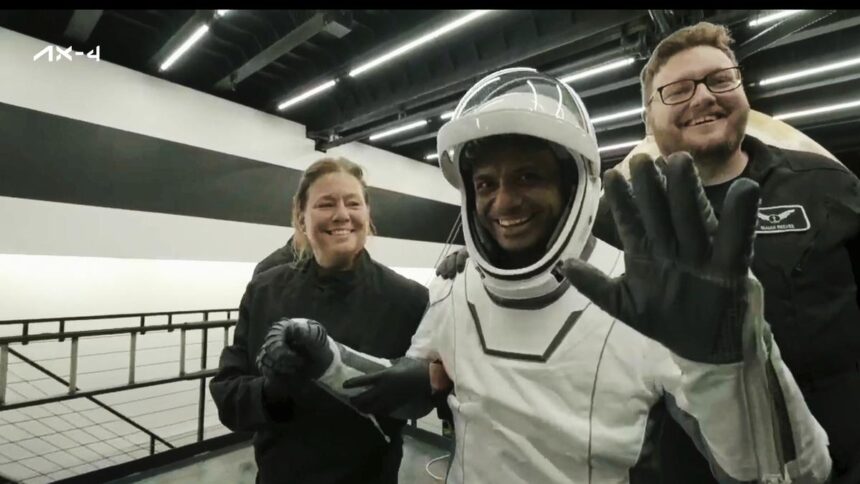Axiom Mission 4 Returns to Earth — A New Chapter for India in Space Begins
In the early hours of July 15, 2025, as the world turned its eyes skyward, history came full circle for a nation still forging its legacy in space. The SpaceX Dragon capsule, returning from orbit as part of Axiom Mission 4 (Ax-4), successfully splashed down off the coast of Florida. Among the crew aboard was Shubhanshu Shukla, an Indian-origin astronaut, whose presence on this groundbreaking mission marks a transformative moment — not just for global space exploration, but for India’s role within it.
The descent of the Dragon spacecraft, slowed by multiple parachutes and guided by onboard navigation, concluded a multi-week mission aboard the International Space Station (ISS). Aboard were four crew members, including Shukla, whose background in aerospace systems engineering and international collaborations made him a vital part of Ax-4’s scientific, logistical, and symbolic objectives.
For millions watching across continents, the splashdown was more than a technical milestone. It was a deeply emotional moment — a powerful reminder of how far India has come in the global space race, and of the increasingly collaborative nature of humanity’s quest beyond Earth.
Axiom Space and the Rise of Private Orbital Missions
To fully understand the importance of this mission, it is necessary to first situate it within the evolving dynamics of global space exploration. Axiom Space, the Houston-based company behind the mission, has been spearheading efforts to create the first commercial space station. With support from NASA, ESA, and SpaceX, Axiom is not just sending astronauts to the ISS — it’s rewriting the rules of who gets to go to space, how they get there, and what they do once aboard.
Axiom Mission 4 represents a significant turning point. It is not simply a government-coordinated scientific expedition. Instead, it is a new hybrid model — one that combines public space infrastructure with private-sector ambition, funded in part by national agencies and in part by corporate and research partnerships.
In this new world, astronauts like Shubhanshu Shukla represent a new generation: scientists, engineers, and explorers who cross borders not just physically but professionally. They are chosen not only for their physical fitness or piloting skills but for their ability to work across disciplines — from biomedical research and AI systems to cultural diplomacy and international cooperation.
Shubhanshu Shukla: The Journey from Earth to Orbit
Born to Indian parents and raised in a family that placed a premium on scientific literacy and civic responsibility, Shukla’s trajectory is nothing short of extraordinary. After completing his initial education in India, he pursued aerospace engineering in the United States, followed by advanced research fellowships in Germany and Japan. His work on autonomous docking systems and orbital fuel optimization quickly earned him recognition among aerospace circles, and his inclusion in the Ax-4 crew was both a nod to merit and a strategic gesture toward global inclusion.
Shukla’s presence on the mission also reignited a deep cultural connection. Indian media followed his journey with the same intensity as they did for Rakesh Sharma, Sunita Williams, and Kalpana Chawla before him. But unlike those previous eras — dominated by state-sponsored programs and astronautic nationalism — Shukla’s mission reflects the plural, decentralized, and commercially integrated nature of today’s space enterprise.
For Indian youth aspiring to careers in space tech, his journey represents a profound narrative shift: space is no longer the domain of a select few backed by national agencies. With the rise of private partnerships, international science, and cross-border academia, a new global workforce is entering orbit — and India is helping to lead that charge.
What Ax-4 Achieved Aboard the ISS
While the mission’s return captured public attention, the real success of Axiom Mission 4 lies in the experiments, deployments, and collaborations carried out aboard the International Space Station. Over the course of the mission, the crew participated in over 25 research modules, including:
- Microgravity gene therapy trials for neurological disorders
- Autonomous robotic arm calibration for next-gen in-orbit construction
- 3D-printed organ scaffolds for future bioprinting applications in space
- Cross-cultural educational broadcasts to schools in five different nations, including India
Shukla played a critical role in the biomedical segment of the mission, particularly in managing zero-gravity cell culture experiments that will feed into cancer research protocols back on Earth. His engineering expertise was also instrumental in troubleshooting a minor cooling system anomaly during the second week of the mission, ensuring continued functionality for vital life support equipment.
A Soft Splashdown, But a Hard Pivot Ahead
As recovery teams approached the capsule floating in the Atlantic Ocean, Shukla was among the first to signal thumbs-up to cameras mounted on the retrieval vessel. Medical checks confirmed that all four crew members were in stable condition. Their re-adaptation to Earth’s gravity — a process that takes weeks — will be supported by NASA’s Johnson Space Center.
Yet even as physical recovery begins, a more strategic pivot is underway.
With Ax-4 successfully completed, attention now shifts to Axiom Station, the first commercial space station under construction, with projected partial deployment by 2027. It is expected that alumni of missions like Ax-4, including Shukla, may return in advisory or leadership capacities — not just as astronauts, but as architects of the post-ISS era.
India, too, is taking note. The Indian Space Research Organisation (ISRO), already making strides in Gaganyaan, Aditya-L1, and lunar missions, is reportedly in early-stage discussions to collaborate with Axiom and SpaceX for specialized mission participation and payload sharing. Shukla’s success may accelerate those plans, offering India a pathway into commercial human spaceflight without the burden of developing an entire platform from scratch.
When Axiom Mission 4 (Ax-4) concluded with a flawless splashdown on July 15, 2025, it wasn’t merely the safe return of astronauts that drew applause. It was the deeper significance — a reaffirmation of the shifting global space paradigm, where nations, private players, and collaborative science now coexist in orbit. The mission, underpinned by complex international alliances and forward-thinking science, represents how modern space exploration has moved far beyond the Cold War-era rivalry and into an age of co-opetition — part cooperation, part competition — on a cosmic scale.
Among the many markers of this shift was the inclusion of Shubhanshu Shukla, the Indian-origin astronaut who played a vital role in the mission’s scientific and diplomatic payload. His participation was not only a win for representation but also a strategic bridge between India’s emerging space ambitions and the established powerhouses of orbital presence — the United States, Europe, and increasingly, commercial giants like SpaceX and Axiom.
The Convergence of Public and Private Space Powers
Axiom Mission 4 is emblematic of a new frontier in space relations, where NASA remains a core enabler, SpaceX provides launch and transport, and Axiom Space orchestrates crew selection, research programs, and international partnerships. This tripartite arrangement brings together public trust, technological scalability, and global buy-in — something that simply didn’t exist during the earlier ISS missions of the 2000s.
For India, a country that once faced satellite embargoes and had to smuggle cryogenic technology, this is a profound reversal of fortunes. It is now courted as a partner, not just a participant. Shukla’s involvement, though through Axiom rather than ISRO, was not seen as a detour from Indian ambitions but rather an expansion of India’s scientific diplomacy.
In fact, India’s Ministry of External Affairs and Department of Space were both quietly involved in supporting Shukla’s mission — facilitating outreach to Indian students, aligning with ISRO’s educational initiatives, and ensuring post-mission collaboration on shared research outputs.
From Cold War to Collaborative Gravity
To understand the global significance of Ax-4, one must recall how the International Space Station (ISS) was once a project of strategic containment — a symbol of détente during the waning years of the Cold War. Built jointly by the U.S., Russia, Europe, Japan, and Canada, the ISS was not just a science lab — it was orbital diplomacy in action.
But as the ISS ages and its decommissioning window approaches (likely between 2030–2032), the center of orbital gravity is shifting — away from intergovernmental coalitions toward modular, commercial, and service-oriented stations. Axiom Space, with its aggressive roadmap and modular architecture, intends to dock its own commercial segments onto the ISS by 2026 and eventually detach as a standalone platform by 2031.
Axiom Mission 4 is part of that broader rehearsal. By demonstrating the feasibility of crewed scientific missions via private launch and coordination, Ax-4 strengthens the case for post-ISS infrastructure — one that blends science with commerce, and diplomacy with innovation.
India’s Strategic Position in the Emerging Space Order
India’s ambitions have long been marked by frugality and indigenous pride. The Mars Orbiter Mission (Mangalyaan), launched at a cost less than a Hollywood blockbuster, remains a case study in efficient aerospace engineering. But as India eyes the next decade — with missions like Gaganyaan (human spaceflight), Shukrayaan (Venus probe), and a potential Indian space station by 2035 — it faces a strategic choice: go it alone, or co-create.
Shubhanshu Shukla’s journey with Axiom may serve as a blueprint for hybrid models of participation, where India retains autonomy in its space science but also plugs into global research ecosystems via trusted partners. Such hybrid models come with both benefits and responsibilities — data-sharing, compliance with global norms, and alignment with international space law.
Additionally, the timing is fortuitous. With China’s Tiangong space station becoming fully operational and increasingly assertive in inviting partners from the Global South, India’s engagement with the U.S. and its allies via missions like Ax-4 helps balance its diplomatic presence in orbit. Space is becoming the next theater of soft power — and India, as a spacefaring democracy, is seen as a natural balancer.
The Science That Binds Nations
Beyond politics and platforms, it is ultimately science that justifies the enormous expense and risk of human spaceflight. Axiom Mission 4’s scientific payload — in which Shubhanshu Shukla played a lead role — showcased the unifying potential of research across cultures and borders.
Several experiments conducted aboard the ISS during Ax-4 had direct relevance to India and developing nations:
- Cardiovascular health under microgravity, with relevance to South Asian populations
- Space-based monitoring of agricultural stress using remote imaging — a prototype that could aid climate-resilient farming in India
- Cancer stem cell behavior in zero gravity, supported in part by an Indo-U.S. research consortium
This new phase of scientific collaboration allows countries to contribute not just as launch providers or payload hosts but as active stakeholders in knowledge creation.
From Representation to Institutional Memory
Perhaps the most significant outcome of Shukla’s mission lies in its symbolic continuity. For India, he joins a small but powerful lineage of spacefarers of Indian origin — from Rakesh Sharma to Kalpana Chawla to Sunita Williams. Each mission has created ripples that reached far beyond science labs — into classrooms, policy tables, and national imagination.
But unlike previous eras, where these missions were celebrated in isolation, today’s environment allows for knowledge continuity. Shukla is expected to be inducted into India’s growing cadre of space advisors, helping ISRO, private space startups, and academic institutions build new standards for human spaceflight, orbital medicine, and aerospace software.
Already, a post-mission collaboration is being discussed between Shukla and Indian institutions such as the Indian Institute of Science (IISc), BITS Pilani, and IIT-Madras, focusing on space-ready bioengineering modules and autonomous spacecraft protocols.
At first glance, a successful space mission like Axiom Mission 4 (Ax-4) might seem like a smooth ride — a team of astronauts launches aboard a sleek spacecraft, conducts scientific experiments in microgravity, and returns to Earth with global acclaim. But beneath the poetry lies precision engineering — a highly coordinated choreography of software, hardware, orbital physics, and mission control protocols, refined to the finest tolerances.
From SpaceX’s Falcon 9 rocket that lifted Ax-4 to orbit, to the Crew Dragon spacecraft that carried Indian-origin astronaut Shubhanshu Shukla and his team to and from the International Space Station (ISS), every piece of equipment was not just engineered for performance — it was built to define the next phase of human spaceflight.
This part of the series explores the technological sophistication behind Axiom Mission 4, with special attention to the systems that made the mission reliable, reusable, and revolutionary.
The Launch: Falcon 9 and Precision LEO Insertion
The journey began on June 25, 2025, with the liftoff of a SpaceX Falcon 9 Block 5 rocket from Launch Complex 39A at Kennedy Space Center, Florida. The Falcon 9 — now widely regarded as the most successful orbital-class reusable launch vehicle in history — performed flawlessly, executing a two-stage burn that placed the Dragon capsule into low Earth orbit (LEO) approximately 408 kilometers above sea level.
What made this launch particularly significant was the use of a flight-proven booster — its eighth mission, in fact — highlighting the incredible strides made in reusability, a concept once deemed science fiction in the human spaceflight domain.
SpaceX’s telemetry systems tracked and transmitted data at sub-second intervals, offering real-time updates to NASA, Axiom, and SpaceX mission control centers. Meanwhile, the autonomous navigation systems onboard Crew Dragon executed the initial orbital insertion corrections, enabling a precise rendezvous trajectory with the ISS.
The Spacecraft: Crew Dragon and Its Smart, Human-Centric Design
The Crew Dragon capsule, named Freedom for this mission, has become the benchmark for modern crewed spacecraft. Designed by SpaceX for both safety and scalability, the capsule features an interface that is equal parts aerospace engineering and user-centered design.
For Ax-4, the spacecraft was customized slightly to accommodate additional payload racks, medical sample containers, and experimental modules for research projects. But its core configuration remained consistent with SpaceX standards:
- Touchscreen-driven cockpit powered by SpaceX’s proprietary software, designed for low training overhead and ergonomic feedback
- Autonomous docking capability that allows Dragon to engage with the ISS without manual piloting, except during override emergencies
- Environmental Control and Life Support Systems (ECLSS), capable of real-time atmospheric regulation, microbial monitoring, and thermal control
- Heat shield using PICA-X material, engineered to withstand re-entry temperatures of up to 1,600°C
Shubhanshu Shukla, as a mission systems engineer with prior research in orbital docking systems, reportedly monitored the automated approach and was prepared for manual override, though it wasn’t required. The Dragon docked seamlessly with the Harmony module of the ISS less than 20 hours after launch.
The ISS Laboratory: A Platform Still Evolving
While the ISS is more than two decades old, its modular design allows for ongoing upgrades and the hosting of new science every year. During Ax-4, the crew used the Destiny Laboratory Module, the Columbus science lab (from ESA), and JAXA’s Kibo module to conduct experiments involving fluid dynamics, cellular biology, and radiation impact on polymers.
The station’s internal systems — including the Canadarm2 robotic arm, Tranquility’s advanced life support systems, and the Node-3 Cupola for Earth observation — gave Ax-4 astronauts an integrated lab experience that few other facilities on or off Earth could match.
Additionally, Ax-4 utilized NASA’s Cold Atom Lab, a unique experiment chamber where ultracold atoms are studied in zero gravity. This has far-reaching implications for quantum mechanics, navigation technologies, and the development of next-generation atomic clocks.
Communication and Safety: Autonomous Systems and Ground Control Synergy
Axiom Mission 4 featured triple-redundant communication protocols, integrating:
- Ku-band satellite links for continuous telemetry
- VHF/UHF backup systems for ISS approach
- Encrypted data relay to Axiom HQ in Houston and SpaceX’s Hawthorne facility
These systems ensured low-latency communication with the crew and real-time adjustments in orbital trajectory or mission parameters if needed. In fact, during a minor course correction on Day 3, Dragon’s onboard AI recalculated fuel efficiency for a mid-orbit thruster burn — a decision later reviewed and approved by Earth-based teams but executed autonomously.
The capsule’s safety mechanisms also deserve mention. Dragon features:
- SuperDraco abort thrusters capable of pulling the capsule away from the launch vehicle within milliseconds
- Acoustic sensor arrays to detect micrometeorite impacts
- Thermal sensors to monitor hull integrity during solar exposure and re-entry
These measures were never activated during Ax-4 — a testament to the mission’s smooth execution — but their presence underscores the redundancy-first mindset of modern space design.
The Return: Controlled Descent and Ocean Recovery
The journey concluded with a targeted de-orbit burn on July 15, 2025. Dragon re-entered Earth’s atmosphere guided by GPS-linked descent modeling and a pre-planned splashdown trajectory, landing in the Atlantic Ocean near Daytona Beach.
Unlike the jolting re-entries of older capsules like Soyuz, Crew Dragon’s descent was meticulously designed for G-force mitigation, aided by four main parachutes and an aerodynamic shape optimized through hundreds of CFD simulations.
The recovery ship, Megan, part of SpaceX’s Atlantic fleet, reached the capsule within minutes, lifting it aboard via crane and beginning medical checks and debriefs on deck.
Shukla was reported to be “in strong physical and psychological condition,” according to the post-recovery medical team — a testament not only to his training but to the engineering environment he had spent the last three weeks in.
What This Means for the Future
The technology stack behind Axiom Mission 4 is more than a marvel — it’s a living, evolving infrastructure, scalable for future missions that may soon include:
- Orbital manufacturing hubs
- Space tourism flights
- Interplanetary crewed journeys to the Moon and Mars
- Private research payloads from developing countries
By proving that commercial systems can operate with the same — if not greater — reliability than legacy space programs, Ax-4 has helped redefine the trust matrix in space travel.
As Axiom and SpaceX now shift toward the launch of the Axiom Station modules and the development of larger human-rated spacecraft like Starship, astronauts like Shubhanshu Shukla are expected to take on new leadership roles — not just as passengers or researchers, but as collaborative engineers of space’s next chapter.







